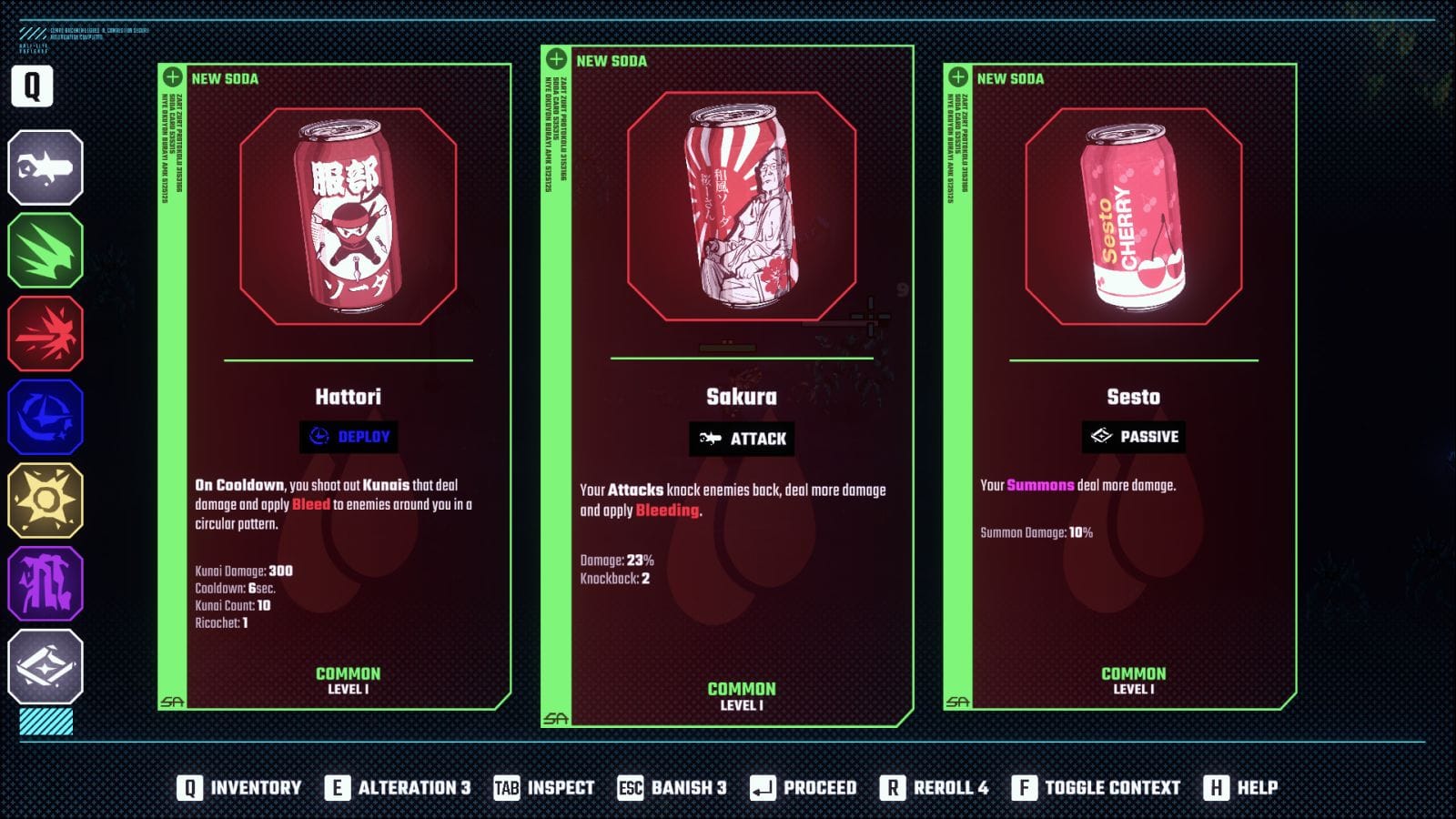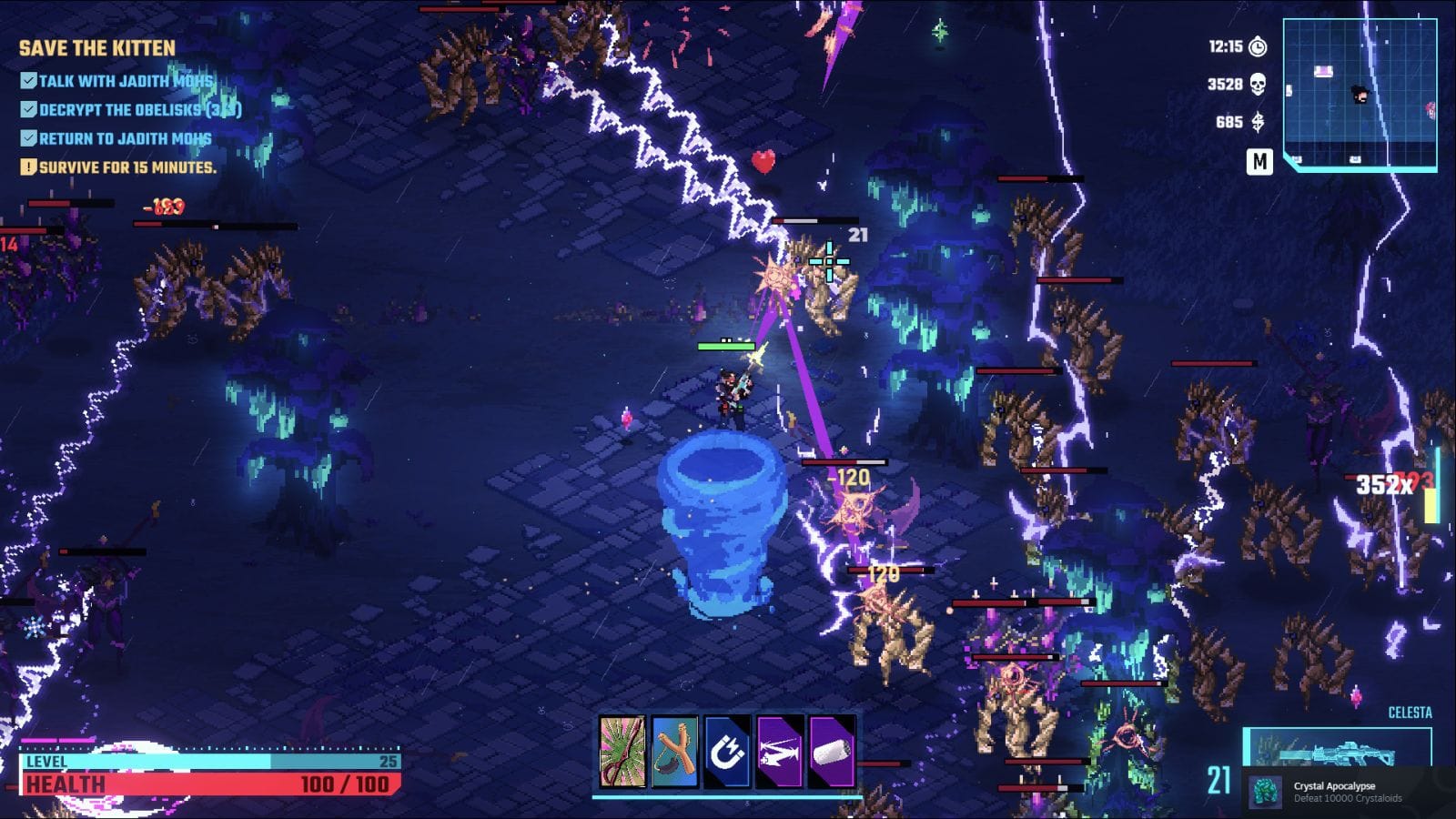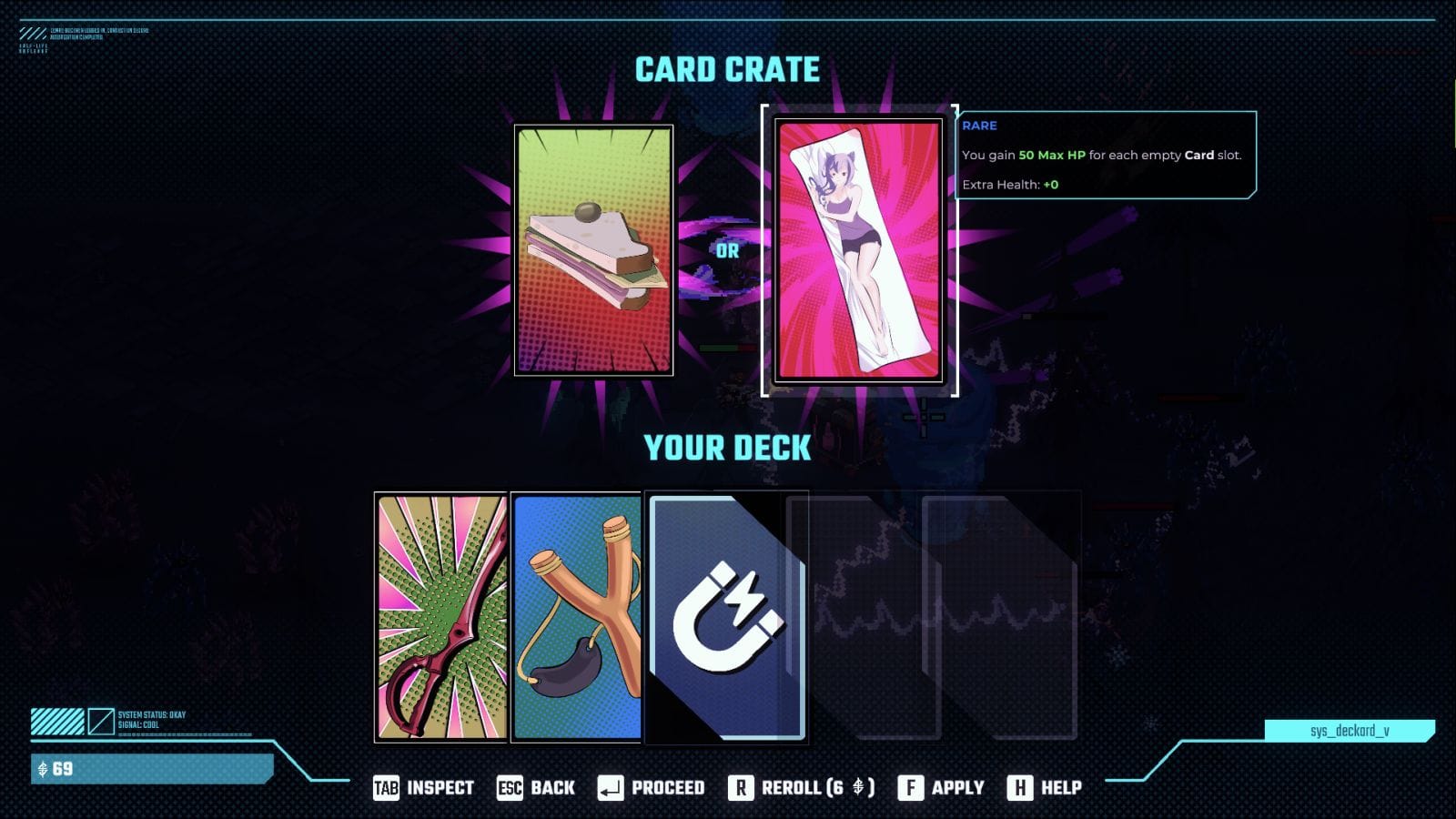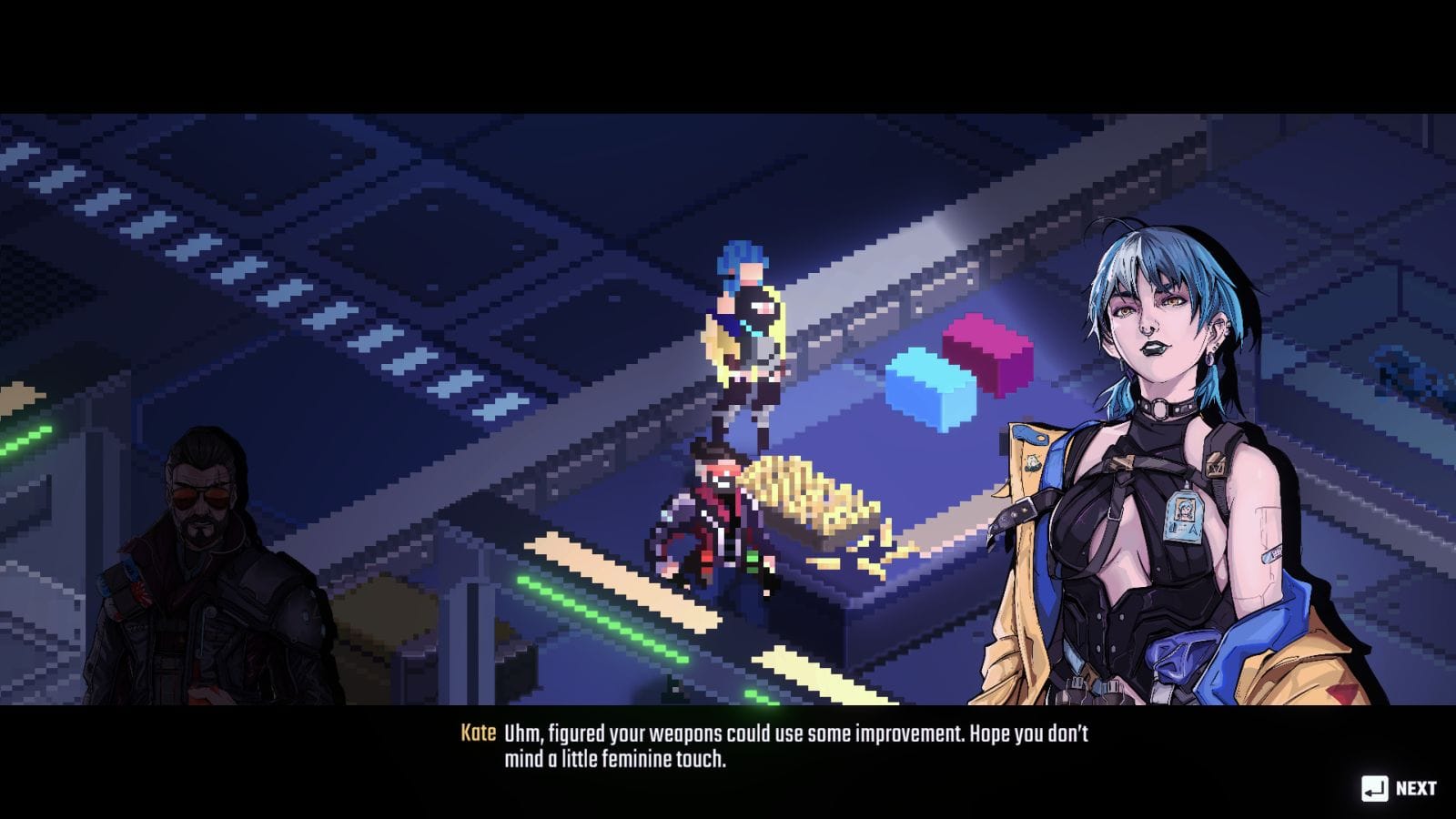
Sodaman is a top-down roguelike, a bullet heaven, and absolutely ridiculous in the best possible way. You play as Sodaman, the best of the best when it comes to super-soldiers. He loves soda and hates the aliens who stand between him and carbonated goodness. What makes this game really pop are the little unique touches it adds to the bullet heaven genre, as well as its fun meta progression.
Let's start with the plot. Usually, getting shot in the abdomen would be where the hero’s story ends. But here, it’s where Sodaman achieves borderline godhood. You see, while fighting alien foes, Sodaman took a gut-shot, and while bleeding on the ground, his blood fused with alien tech. This cranked our caffeinated captain up to 11 and turned him into a fizzy force of nature. Now, years after he thought his last battle was finished, the aliens are back with their anti-soda antics, turning every soda flat and flavorless. It’s up to Sodaman to set things right by taking to space in his ship and uncovering what’s happening. As you can tell, the plot is pretty over the top, and it works really well in a genre known for large-scale mob slaughter.

On the gameplay side, the ship serves as your base of operations, with various crew members serving roles such as guides to the planets below or vendors who sell upgrades. There are various operations that take place on different planets. Each operation has three levels of difficulty with their own objectives to complete and bosses to fight, all of which culminate in a final level of difficulty called Chaos Mode. We’ll get into all of the vendors and the benefits of Chaos Mode later. Once an operation is chosen, Sodaman is deployed to the planet in a drop-pod, and waves of enemies immediately begin to attack, which is the standard fare for this genre. Foes on the first planet, Crystal Heaven, are sentient crystals; shooting them feels satisfying due to the shattering noises they make when they die. The strong sound design for the guns helps, too. It’s gravel-in-a-blender visceral. As of right now, only Crystal Heaven is complete. But the second operation, Proclivitas, has a preview mission available.
As you mow down waves of aliens, you’ll start picking up cash and experience crystals, the latter eventually granting you a level-up. With each level-up, you’re presented with a batch of three upgrades, but you can only pick one. Upgrades take the form of Sodas, which have various effects and levels of rarity. Effects are grouped into colors, which typically denote elemental types, like orange for fire, purple for lightning, green for poison, etc. The three Soda choices you’re given will always be of the same color, but you can re-roll both the color and effects, although re-rolls have limited uses. Each elemental type has its own set of enhancement types, such as passives, attacks, strikes, sparks, and deploys, which affect different parts of combat. For example, Deploy Sodas pretty much summon forth something to fight for you, whereas Attack Sodas add damage and effects to your bullets.

You can choose the same card multiple times throughout different level-ups, which will enhance its effects, although it won't always enhance all aspects of the Soda at once. Take the Hattori Soda, for example, the description of which reads, “On Cooldown, you shoot out Kunais that deal damage and apply bleed to enemies around you in a circular pattern.” In this example, the kunai damage, the cooldown of the ability, the number of kunai thrown, and the number of times they ricochet are all stats at play. As you upgrade the card, which stats are being upgraded will alternate. Let's say that level two grants you more damage and better cooldown, whereas at level three, more kunai are sent out, and they ricochet more. This kind of upgrade system means that you can memorize power spikes and structure builds with confidence.
You also need to account for Soda rarity, of which there are five: common, rare, epic, legendary, and artifact. The higher the level, the better the stats of the Soda. Think of it like cutting the line and getting a head start on upping the stats of your Soda. If you were to get a level 1 common rarity Inferno Soda, your shots would deal 28% more damage and have a 28% chance to apply Blaze, a fiery damage-over-time effect. However, if you were to get the same Soda at the same level but with an epic rarity, your shots would deal 49% more damage with a 48% chance to apply Blaze. That’s a BIG difference. All of that being said, creating a strong build in Sodaman is quite fun! There are even some quality of life features, like an auto aim mode, an auto shoot mode, and a context button that will further explain what the effects of your Soda do. I really wish more roguelikes had that last feature!

There are a few other ways to gain bonus stats on a run, like by finding chests, vending machines, and points of interest, all of which are marked on a handy map. Starting with chests, these require you to stand within a radius around them to open, leaving the circle will cause you to lose progress. Once you successfully open one, you’re granted the choice of either of two cards to fit into one of five card slots. Cards are of varying rarity, but unlike Sodas, they cannot be upgraded to a higher rarity level. The Card options can be re-rolled for some cash, with the cost increasing after each re-roll. It’s important to consider that cash is also spent on permanent upgrades from vendors outside of the run. Re-rolling gives you the chance to get incredibly powerful cards which can help you sustain your run for much longer, and potentially give you more cash than you put in. However, upgrades from vendors are a guaranteed permanent benefit, so choose wisely. On a quick note, there are other chests which grant health or speed boosts scattered around as well, and they just need to be shot to open.
Then we have vending machines and points of interest. Vending machines will upgrade one, three, or five of your Sodas depending on how lucky you are. One of the upgrades may be a hefty sum of cash, which is also quite welcome. Moving on to points of interest, they’re usually oddities that give you buffs. At one point, I found a giant shoe that made me faster, and another time I found a weird dog that offered me a few buffs to choose between.


Players have plenty of ways to increase their power while on a planet, but the best way to set yourself up for success is through buying and upgrading guns and implants from merchants on your ship. Whether you complete your mission or get sent packing with a few bruises and some cash to spend, you’ll always end up back with your crew. As of right now, there are four crewmates to talk to: Kate, the armorer; Teoman, the ripperdoc; Sophia, an AI assistant; and the Admiral, who’s… well… the Admiral.
Kate and Teoman are both merchants, so I’ll go over them first. Kate sells a variety of guns, each with their own strengths, weaknesses, and stat upgrade paths. For example, the fully upgraded SMG will deal less damage per shot than the unupgraded light machine gun, but it has a much better fire rate and a unique trait that adds damage every time its bullets ricochet. Teoman, on the other hand, sells body augmentations that grant special bonuses. You can find the pre-requisite blueprints for augmentations by defeating powerful enemies. These augmentation implants can fit into the eye, arm, hand, stomach, boxer (as in the underwear), and leg slots. My arm augmentation, the Nova Duplicator, makes every third bullet ricochet and pierce more, as well as increasing my magazine size and fire rate, which pairs quite well with the SMG’s bonus effect. You can upgrade your augmentations using Dark Matter Orbs, which are obtained by playing on Chaos Mode. Before starting Chaos Mode, you’re given optional difficulty modifiers; the more of which you have active, the higher the drop rate for Dark Matter Orbs. Augmentations are powerful enough on their own, so increasing the potency of their effects can massively influence your future runs.





Moving on to Sophia and the Admiral, they’re simpler in terms of gameplay. Sophia only really talks when the story moves forward, and the Admiral is our hub for missions, so to get to a planet, you go through her first. I’m hoping that they add a little more to Sophia as time goes on, because as of right now, she just stands there, only offering a quick text prompt when spoken to. On another note, the characters’ voices sound like they’re AI, and given that I didn’t see any voice talent listed in the credits, I’ll assume that’s the case. That being said, it’s not awful, but the cadence of their speech could use some work.
Speaking of audio, the soundtrack is really good. I found myself bopping to techno music on more than a few occasions. It really does enhance the combat, and I can’t imagine the game with a different sound. Exploring the alien landscape with fresh beats makes the game feel unique, even if it’s a tried-and-true genre.
To wrap up, I’m quite excited about Sodaman. It’s a standout among bullet heaven roguelikes, with interconnected build crafting that surprised me with its depth at each turn. The factors that will play off of each other in a run are numerous, and while the buffs are always piling up, so is the challenge. The game itself is like a shaken can of soda; it might look standard at first glance, but once you pop the top, boy is it a rush!
